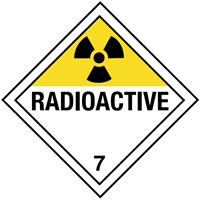
 Print
Print
Chemical Datasheet
URANYL SULFATE |

|
Chemical Identifiers
| CAS Number |
UN/NA Number |
DOT Hazard Label |
USCG CHRIS Code |
|
|
|
|
|
| NIOSH Pocket Guide |
International Chem Safety Card |
|
Uranium (soluble compounds, as U)
|
none
|
NFPA 704
data unavailable
General Description
An odorless yellow-green solid. Sinks in and mixes with water. A hydrate of formula (H2SO4)2.7H2O is also known.
Hazards
Reactivity Alerts
Air & Water Reactions
Soluble in water.
Fire Hazard
Excerpt from ERG Guide 161 [Radioactive Materials (Low Level Radiation)]:
Some of these materials may burn, but most do not ignite readily. Many have cardboard outer packaging; content (physically large or small) can be of many different physical forms. Radioactivity does not change flammability or other properties of materials. (ERG, 2024)
Health Hazard
Inhalation of dust may irritate nose and throat. Contact with eyes causes irritation. (USCG, 1999)
Reactivity Profile
Inorganic oxidizing agents can react with reducing agents to generate heat and products that may be gaseous (causing pressurization of closed containers). The products may themselves be capable of further reactions (such as combustion in the air). The chemical reduction of materials in this group can be rapid or even explosive, but often requires initiation (heat, spark, catalyst, addition of a solvent). Inorganic oxidizing agents can react violently with active metals, cyanides, esters, and thiocyanates. Explosives often consist of an inorganic oxidizing agent mixed in intimate contact with a reducing agent. Gunpowder is such a mixture. Other examples are a mixture of sugar (an organic compound) plus sodium chlorate and magnesium (an inorganic reducing agent) plus barium peroxide. Compounds that inherently contain a group that is a reducing agent and an oxidizing agent are classed in both Group 44 (Inorganic Oxidizing Agents) and in Group 45 (Inorganic Reducing Agents; for example, ammonium nitrate). The strongly oxidizing elements oxygen and fluorine are classified here. Inorganic oxidizing agents that are also acids (such as nitric and perchloric acids) are not included in this group. They are in Group 2 (Acids, Inorganic Oxidizing).
Belongs to the Following Reactive Group(s)
- Non-Redox-Active Inorganic Compounds
Potentially Incompatible Absorbents
No information available.
Response Recommendations
Isolation and Evacuation
Excerpt from ERG Guide 161 [Radioactive Materials (Low Level Radiation)]:
IMMEDIATE PRECAUTIONARY MEASURE: Isolate spill or leak area for at least 25 meters (75 feet) in all directions.
LARGE SPILL: Consider initial downwind evacuation for at least 100 meters (330 feet).
FIRE: When a large quantity of this material is involved in a major fire, consider an initial evacuation distance of 300 meters (1000 feet) in all directions. (ERG, 2024)
Firefighting
Excerpt from ERG Guide 161 [Radioactive Materials (Low Level Radiation)]:
Presence of radioactive material will not influence the fire control processes and should not influence selection of techniques. If it can be done safely, move undamaged containers away from the area around the fire. Do not move damaged packages; move undamaged packages out of fire zone.
SMALL FIRE: Dry chemical, CO2, water spray or regular foam.
LARGE FIRE: Water spray, fog (flooding amounts). (ERG, 2024)
Non-Fire Response
Excerpt from ERG Guide 161 [Radioactive Materials (Low Level Radiation)]:
Do not touch damaged packages or spilled material. Cover liquid spill with sand, earth or other non-combustible absorbent material. Cover powder spill with plastic sheet or tarp to minimize spreading. (ERG, 2024)
Protective Clothing
Approved dust respirator; goggles or face shield; protective clothing (USCG, 1999)
DuPont Tychem® Suit Fabrics
No information available.
First Aid
Get medical attention after all exposures to this compound.
INGESTION: give large amounts of water; induce vomiting.
EYES: flush with water for at least 15 min.
SKIN: flush with water. (USCG, 1999)
Physical Properties
Flash Point: data unavailable
Lower Explosive Limit (LEL): data unavailable
Upper Explosive Limit (UEL): data unavailable
Autoignition Temperature: data unavailable
Melting Point: data unavailable
Vapor Pressure: data unavailable
Vapor Density (Relative to Air): data unavailable
Specific Gravity:
3.28
at 68°F
(USCG, 1999)
- Denser than water; will sink
Boiling Point: data unavailable
Molecular Weight:
420.2
(USCG, 1999)
Water Solubility: data unavailable
Ionization Energy/Potential: data unavailable
IDLH:
10 mg U/m3
; A potential occupational carcinogen.
(NIOSH, 2024)
AEGLs (Acute Exposure Guideline Levels)
No AEGL information available.
ERPGs (Emergency Response Planning Guidelines)
No ERPG information available.
PACs (Protective Action Criteria)
No PAC information available.
Regulatory Information
EPA Consolidated List of Lists
No regulatory information available.
CISA Chemical Facility Anti-Terrorism Standards (CFATS)
No regulatory information available.
OSHA Process Safety Management (PSM) Standard List
No regulatory information available.
Alternate Chemical Names
- URANIUM SULFATE
- URANIUM SULFATE TRIHYDRATE
- URANYL SULFATE
- URANYL SULFATE TRIHYDRATE


 Print
Print
